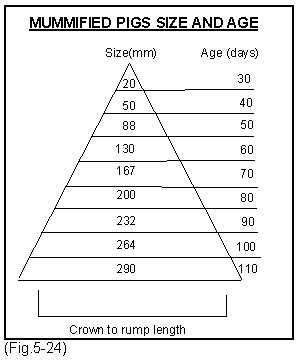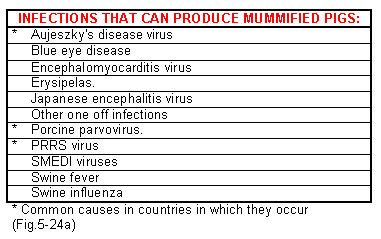



Foetal death and the mummified pig
From approximately 30 days of age through to 115 days the foetus is maturing. This means that the skeletal system is developing and if the piglet dies, it is not completely absorbed and a mummified foetus remains. The approximate age when a mummified pig has died can be determined by measuring the length from the crown of the head to the rump or tail base. (Fig.5-24)

There are two possible causes of mummies. First, a piglet dies because there is a large litter and insufficient space in the womb. Second, there is infectious disease, usually of a progressive nature, at any stage during the period of pregnancy. In the first instance, a study of the records will show that the mummified pigs are occurring in large normal litters. For example, a litter size of 14 alive, 1 dead, 1 mummified is of no significance provided the remainder of the litter is normal and healthy. If however, the litter size is 6 born alive, 2 dead and 4 mummified, this indicates disease during the pregnancy causing mortality. By measuring the size of the mummified pigs, we can determine at what stage in pregnancy the disease occurred. Alternately, if the mummified pigs are of a variable length this is evidence of progressive disease over a period of time. Some viral infections affect the foetus from 30 days onwards and progressively spread during the period of pregnancy. Porcine parvovirus is a typical example.
Once the piglet inside the womb reaches 70 days of age it becomes immuno-competent. This means that its immune system has started to develop and therefore can respond to any infection that challenges it and attempt to protect itself. For example, if pigs inside the womb are infected with parvovirus beyond 70 days they respond by producing an immunity and thereby, no disease. By sampling the blood of such piglets at birth, before they have suckled, we can tell from presence or absence of antibodies whether indeed this event had taken place. An alternative to this would be PRRS infection, which does not affect the foetus during the mid period of pregnancy, but only as it becomes immuno-competent after day 70. In this case, the virus actually kills the pigs and therefore there will be evidence of late mummified pigs, death having occurred at any time from day 80 to the point of farrowing. Thus, by studying the numbers relative to total litter size and the time when death must have occurred, we can get a good indication as to possible disease causes.
The Significance of Mummified Pigs
- Large numbers of normal piglets born alive and a few mummified pigs - unlikely to be due to disease.
- Small numbers of piglets alive and large numbers of mummified pigs - more likely to be due to disease.
In group 5 losses, total numbers born will be the same, but numbers alive will be reduced with corresponding increases in still-births and mummified piglets. Litter size variation will be increased, with farrowing rates decreased. Abortions of course can be a major cause of loss in this group and repeats may be regular or irregular.








